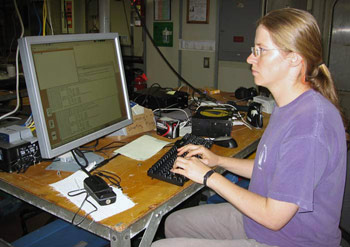Interview with Sarah Webster
by Dan Conrad

Sarah, tell me about your work on this cruise.
We are using software that I have written to allow us to send data between the vehicle and the ship without using a cable. The data is encoded as high frequency sound and sent out over an "acoustic underwater modem" (like an underwater speaker/microphone). We can use these "data packets" to calculate the range between the ship and the vehicle.
What are the applications for navigation of underwater vehicles?
My field may sound very narrow and specialized, but there are actually lots of applications for underwater vehicles. They can cover a lot more ground than vehicles that are driven around by remote control, which makes them ideal for underwater surveys, such as mapping the ocean floor. Also, methods of navigation that I am working on are applicable to vehicles on land and in space as well.
So how did you choose to work on AUVs and go to graduate school?
I first became involved in ocean engineering-related research at MIT by working with Dr. David Mindell and the Deep Sea Archaeology Research Group. He was interested in using underwater vehicles to aid in underwater archaeology. I didn't have any experience with underwater vehicles but I did have some experience working at sea because I had participated in SEA Semester, a sail-training and ocean science program run by Sea Education Association (a fantastic program).
After graduating, I went to work at Woods Hole Oceanographic Institution (WHOI) as an engineer, developing archaeological excavation tools for a project lead by Dr. Robert Ballard and the Institute for Exploration.
While working at WHOI, I realized that I really like working in a research environment, but if you want to have the freedom to do your own research you have to have a PhD. That allows you to turn your interesting research ideas into formal proposals, get funding and pursue your own interests.
Do you find that being an engineering student has allowed you to become associated with a variety of disciplines?
Definitely. It brings me in contact with people doing a lot of different research. I like the fact that the engineering we do enables different types of scientific studies. We aren’t doing engineering just for engineering’s sake; we are doing engineering so we can accomplish something, like learning about the ocean, or looking at archaeological sites too deep for human divers.
Did you ever work on a shipwreck?
Yes, while at WHOI, I worked on a project with the Institute for Exploration that partially excavated a late 5th century Roman shipwreck in the Black Sea. The shipwreck was in water that was anoxic (very low oxygen content) so that even the wood from the ship was preserved. The mast was still standing and you could see the marks on the wooden beams where they had been squared off. For this project, I was designing the tools used by the remotely operated vehicle, Hercules, for excavation, such as suction pumps and water jets to gently excavate the site.
You are the only woman on the science engineering team. Do you think progress has been made in bringing more women into the field?
Progress has definitely been made. My incoming class at MIT (Class of 1999) was 42% women. But there is still a significant difference in the percent of women going into engineering in college versus men.
I believe that part of the solution is to expose girls to engineering in middle school, before they get turned off from math and science because they perceive that it isn't cool and only has to do with cars and mechanics. Mechanical engineering is so much broader than that, with lots of applications that have more of a human factor, such as environmental engineering and biomedical engineering.
I helped start a program at Johns Hopkins University for middle school girls from Baltimore City and Baltimore County schools. Often, programs related to engineering are competitive, which doesn’t necessarily appeal to this age group. In our program, we have a theme for the day, and all sorts of projects related to that theme, such as cleaning up an abandoned city lot and making it into a playground, or creating devices to help people with disabilities. Each group of 3 or 4 girls works on a different project with one or two female undergraduate mentors. This lets the girls design and cut and build and glue and really get to be creative in a fun, supportive environment.
What do you see yourself doing after you complete your Ph.D?
I would like to continue doing research and possibly teaching. I am excited about having the opportunity to live in different places and will probably look for a post-doctoral fellowship outside the US. That is one of the benefits of working in this field. There is lots of great research happening all over the world.
How can a middle or high school student get to the place you are now?
A good background in math and science is important. In addition to that, though, showing up and being enthusiastic and willing to learn is just as important. I got to work with Dr. David Mindell at MIT because he sent out an email looking for people to help do research in underwater vehicles and archaeology, and I answered it. I had zero prior experience with underwater vehicles and no reason to think I was qualified, but it sounded really interesting. It turned out that I was the only person that responded to his email. I just showed up and showed interest, and ended up working on some really cool projects. If there is something you want to do, not only is it okay to be assertive, it's great! Often it is exactly what employers or supervisors want.
[Back
to top]
|
